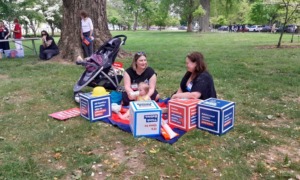 There has been an explosion of interest in providing young people with learning opportunities in science, technology, engineering and math (STEM). Many have argued correctly that afterschool and summer programs are perfectly situated to respond to this interest. After all, the out-of-school (OST) environment provides the teacher and learner with a flexibility not found in school — the freedom to choose interesting topics, the ability to extend the learning activities across time (days or even weeks), the advantage of working in smaller groups, and use of the larger community and their surroundings as a classroom. However, the rush to offer STEM-related activities has not necessarily resulted in quality programming.
There has been an explosion of interest in providing young people with learning opportunities in science, technology, engineering and math (STEM). Many have argued correctly that afterschool and summer programs are perfectly situated to respond to this interest. After all, the out-of-school (OST) environment provides the teacher and learner with a flexibility not found in school — the freedom to choose interesting topics, the ability to extend the learning activities across time (days or even weeks), the advantage of working in smaller groups, and use of the larger community and their surroundings as a classroom. However, the rush to offer STEM-related activities has not necessarily resulted in quality programming.
Many OST managers figured that STEM activities meant a focus on content, without an eye on what makes for a good learning experience. But successful STEM activities are more than content. They are designed to ignite young people’s imagination and involve them in ways that excite them as learners. Those responsible for providing STEM activities need to provide staff training using a framework for learning and engagement.
Research on learning and engagement suggest several principles to guide the design and implementation of activities. To begin, learning activities must be active. They must be collaborative and meaningful to the participant. They should support mastery and they should expand the horizons of participants. These principles have become influential in how the state of California now defines quality OST learning programs.
According to Carol Tang, former director of the Coalition for Science After School, these principles are relevant when applied to STEM. She says: “A lot of young people are turned off because they had bad experiences learning about science. If you look at these learning principles, I think it’s a way to really look at science education, and take a step back and say it is really about doing science. If you think about what scientists do, they are active and hands on, they make things and break things, they talk to their peers, they learn from their mistakes and they get better with time. If we don’t get kids excited about science then they can learn as many facts and figures that their brains can hold, but that’s not really going to help us.”
SRI International recently published the first part of a five-year National Science Foundation funded research project, the Afterschool Science Networks study. In this important report, SRI presented case studies of science activities in California afterschool programs and identified “staff capacity” as one of several limitations. Many of the issues in staff capacity involved the failure to engage and can be addressed through staff development on how to engage young people as learners. Part of this is allowing young people to learn in a hands-on fashion and facilitating questions instead of giving answers.
According to Dr. Ann House, leader of the SRI study, “We believe that the learning principles developed by the Learning in Afterschool & Summer projectare very well aligned with inquiry science activities. For example, conducting investigations, collecting data and designing solutions make learning activities active and meaningful, and also support mastery. Engaging in scientific reasoning and argument deepens the meaningfulness of activities and often involves collaboration. Finally, investigating science phenomena and designing solutions broadens youth’s horizons. Their horizons can also be broadened as they learn more about STEM-related careers and how STEM skills and knowledge can help them become more informed citizens.”
The growing number of afterschool programs focused on STEM is an exciting development. But if children are to develop a growing interest in STEM topics, we need to think about how children learn when we design the activities and prepare adult staff to facilitate them. This can be accomplished through training and materials that offer a framework for learning and engagement.
Sam Piha is the founder and principal of Temescal Associates, a consulting group dedicated to building the capacity of leaders and organizations in education and youth development. Sam was recently named by the National AfterSchool Association as one of the Top 25 Most Influential People in AfterSchool, 2014.






























